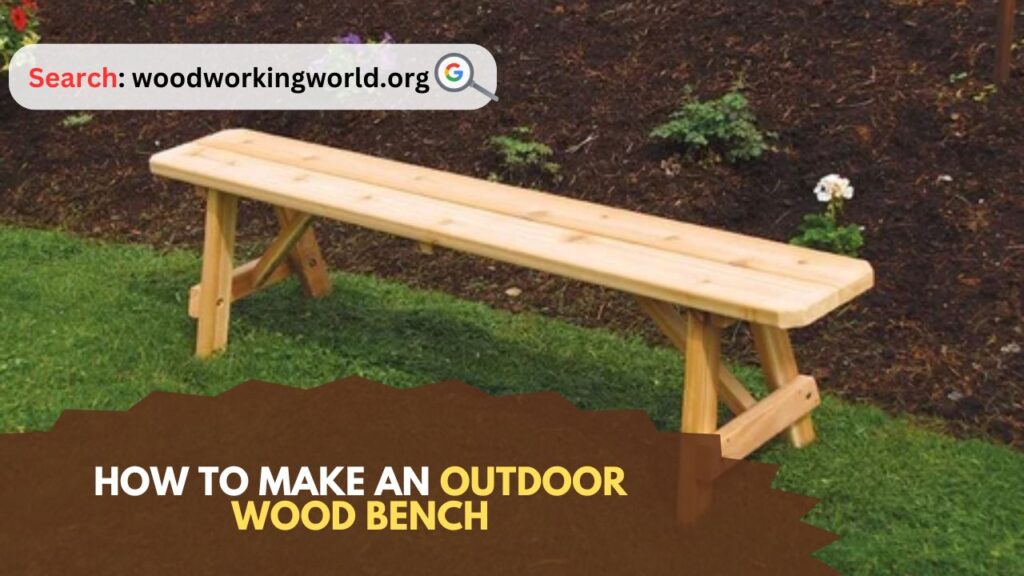Outdoor Wood Bench: Creating an outdoor wood bench can be a rewarding and satisfying project. Whether you’re a seasoned woodworker or a beginner, constructing a bench can be a manageable and enjoyable task that adds both functionality and beauty to your outdoor space. This article will guide you step-by-step through the process of building a sturdy and attractive wood bench for your garden, patio, or backyard.

How to Make an Outdoor Wood Bench
Materials and Tools Needed
Before you start, gather all the necessary materials and tools:
Materials:
- Lumber (Cedar, Redwood, or Pressure-treated Pine)
- 2×4 boards for the frame
- 2×6 boards for the seat
- 2×3 or 1×3 boards for the backrest slats
- 4×4 posts for the legs
- Wood screws (3-inch and 2-inch)
- Wood glue
- Sandpaper (120 and 220 grit)
- Exterior wood stain or paint
- Weather-resistant wood finish
Tools:
- Tape measure
- Pencil
- Circular saw or miter saw
- Drill with bits
- Screwdriver
- Clamps
- Carpenter’s square
- Level
- Safety goggles
- Work gloves
Step 1: Designing Your Bench
First, decide on the dimensions of your bench. A standard outdoor bench seat is typically 16-18 inches high, 18-20 inches deep, and around 48-60 inches wide. Customizing these dimensions to suit your space and preferences is encouraged. For this guide, we will build a bench that is 48 inches wide, 18 inches deep, and 18 inches high.
Step 2: Cutting the Lumber
Measure and cut the following pieces from your lumber:
- Four 2×4 boards at 18 inches for the seat supports
- Two 2×6 boards at 48 inches for the seat
- Four 4×4 posts at 18 inches for the legs
- Two 2×4 boards at 48 inches for the front and back apron
- Four 2×3 or 1×3 boards at 18 inches for the backrest slats
- Two 2×4 boards at 20 inches for the armrests
Tip: Ensure all cuts are straight and accurate. Use a carpenter’s square to mark your cuts and a saw guide to keep your saw blade straight.
Step 3: Assembling the Frame
- Create the Seat Frame:
- Lay two 18-inch 2×4 boards parallel to each other on a flat surface.
- Position the 48-inch 2×4 boards at the ends of the 18-inch boards to form a rectangle.
- Use wood glue and 3-inch screws to secure the frame. Pre-drill holes to prevent splitting the wood.
- Attach the Legs:
- Stand the frame on its edge.
- Attach the 18-inch 4×4 posts to each corner of the frame using wood glue and 3-inch screws.
- Ensure the legs are flush with the top edge of the frame.
- Add the Front and Back Apron:
- Attach the 48-inch 2×4 boards to the front and back of the frame, flush with the top edge.
- Secure with wood glue and 3-inch screws.
Step 4: Creating the Seat
- Attach the Seat Boards:
- Place the two 48-inch 2×6 boards on top of the frame, leaving a small gap (1/8 inch) between them for water drainage.
- Secure the boards with wood glue and 2-inch screws.
- Sand the Seat:
- Sand the edges and surface of the seat boards with 120 grit sandpaper to remove any rough spots and ensure a smooth finish.
Step 5: Building the Backrest
- Attach the Backrest Supports:
- Measure 6 inches from the top of each back leg and mark.
- Attach an 18-inch 2×4 board horizontally at this mark on each side of the bench using wood glue and 3-inch screws. These will serve as the supports for the backrest slats.
- Install the Backrest Slats:
- Space the 18-inch 2×3 or 1×3 boards evenly along the backrest supports.
- Attach each slat using wood glue and 2-inch screws.
- Sand the Backrest:
- Sand the edges and surface of the backrest slats with 120 grit sandpaper.
Step 6: Adding Armrests
- Attach the Armrest Supports:
- Measure and mark 10 inches up from the bottom of the front legs.
- Attach an 18-inch 2×4 board horizontally at this mark on each side using wood glue and 3-inch screws. These will serve as the supports for the armrests.
- Install the Armrests:
- Place the 20-inch 2×4 boards on top of the armrest supports and the backrest supports, extending slightly beyond the front legs.
- Secure with wood glue and 3-inch screws.
- Sand the Armrests:
- Sand the edges and surface of the armrests with 120 grit sandpaper.
Step 7: Finishing Touches
- Final Sanding:
- Sand the entire bench with 220 grit sandpaper for a smooth finish.
- Staining or Painting:
- Apply an exterior wood stain or paint to protect the wood from the elements.
- Allow the stain or paint to dry completely according to the manufacturer’s instructions.
- Applying a Wood Finish:
- Apply a weather-resistant wood finish to seal and protect your bench.
- Allow the finish to dry completely before using the bench.
Step 8: Placement and Enjoyment
- Choose a Location:
- Place your new bench in a desired location in your garden, patio, or backyard.
- Leveling:
- Use a level to ensure the bench sits evenly on the ground.
- Adjust the legs as needed to achieve a stable and level position.
- Accessorize:
- Add cushions or outdoor pillows for added comfort and style.
- Consider placing the bench near a scenic spot or in a shaded area for a relaxing seating experience.
Tips for Maintenance
- Regular Cleaning:
- Keep your bench clean by regularly wiping it down with a damp cloth to remove dirt and debris.
- Reapply Finish:
- Periodically reapply a weather-resistant finish to maintain the wood’s protection and appearance.
- Winter Storage:
- If possible, store your bench indoors during the winter months to prolong its lifespan.
Conclusion: Outdoor Wood Bench
Building an outdoor wood bench is a fulfilling project that enhances your outdoor space with a functional and aesthetically pleasing piece of furniture. By following these detailed steps, you can create a bench that will provide comfort and enjoyment for years to come. Whether you’re looking to relax with a book, entertain guests, or simply enjoy the beauty of your garden, a handcrafted wood bench is a perfect addition to your outdoor area. Happy building!
I hope this article on Outdoor Wood Bench has been helpful. If you have any further questions, please feel free to leave a comment below.
Video
